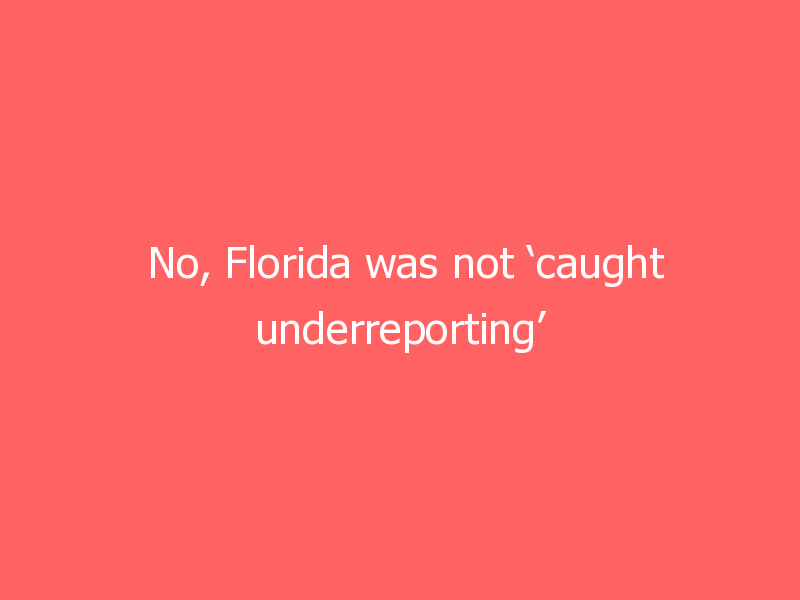An epidemiologist explains a claim on Twitter is a misinterpretation of data provided by the state.
ST. PETERSBURG, Fla. — As new COVID-19 cases and hospitalizations continue to surge in Florida, and are expected to climb higher, all eyes are on the data being reported by the state.
Florida moved to offering only weekly reports in June while daily case numbers are provided to and then reported by the Centers for Disease Control and Prevention (CDC).
Questions have been raised throughout the pandemic about the accuracy of the data being reported by the state—from discrepancies found in the FLDOH dashboard tracking COVID-19 in schools, to the removal of a data manager with the health department who claimed she was ousted over her concerns about data that was not being released to the public.
Now a Dutch news site is reporting the state is underreporting deaths in its latest report. Harvard epidemiologist Dr. Eric Feigl-Ding amplified the claim on Twitter to his half a million followers. The claim was also picked up and shared by Florida’s Agriculture Commissioner and Democratic candidate for governor Nikki Fried.
THE QUESTION
Was Florida caught underreporting COVID-19 deaths in latest report?
THE SOURCES
THE ANSWER
No, Florida was not ‘caught underreporting’ COVID-19 deaths in latest report.
WHAT WE FOUND
In the latest weekly COVID report provided by the state of Florida, it shows 175 new deaths for the week of July 30 – August 5. However a tweet from BNO Newsroom, a news agency headquartered in the Netherlands, states the number of deaths is actually much higher.
A comparison of the cumulative death count in the latest report to the previous week’s report shows 616 deaths, not 175.
“Florida is caught underreporting COVID-19 deaths,” Dr. Eric Feigl-Ding, a Harvard epidemiologist with the Federation of American Scientists, said in his tweet sharing the BNO Newsroom claim.
Agriculture Commissioner Nikki Fried also shared the BNO Newsroom tweet saying, “I hope this was an honest mistake.”
Dr. Jason Salemi, an epidemiologist specializing in public health surveillance and data at the University of South Florida, says it comes down to a misinterpretation of the data.
And this is a frequent occurrence, Salemi explained in a video he posted to his YouTube account in June.
This time is no different.
“We’re used to death information being problematic due to the lag,” he said in the video, explaining a similar instance in June when new deaths reported from the previous week totaled 40, while the difference between cumulative death totals from one weekly report to the next actually totaled 280 new deaths.
“That means we had 280 new deaths that were reported … that we’ve learned about in the past week,” Salemi said in the video, whereas the 40 deaths is the “number of people who actually died from COVID-19 during the week in the report.”
“So the two numbers are pointing to very different things,” he cautioned. “There’s a big difference between COVID-19 deaths, based on when they are reported versus when they occurred.”
For this reason, says Salemi, the “previous week” metric isn’t very useful.
Ongoing research has shown a clear and consistent connection between COVID-19 case rates and deaths, and the time lag between the two.
There are two reasons for this “death lag” associated with COVID-19 cases, according to the COVID-19 Tracking Project, a volunteer organization that had been collecting and publishing data to understand the COVID-19 outbreak in the United States.
The first is clinical because it takes time for cases to progress to hospitalization or death, while the second reason is that deaths are complicated to record.
“The infrastructure to record them is often outdated, so producing a comprehensive count takes time,” the COVID Tracking Project explained in May.
They might seem like anomalies or data errors, Salemi said, but they’re not.
Salemi said he posted a video explanation out of frustration over the lack of understanding in how to interpret the data.
“They seem to work from the baseline assumption that the Florida DOH are either hiding something or incompetent,” he said in an email to 10 Tampa Bay.
“I put out a YouTube video explaining that the data may be difficult to understand at first glance, but are not incorrect or trying to hide something.”
Originally found on Read More








